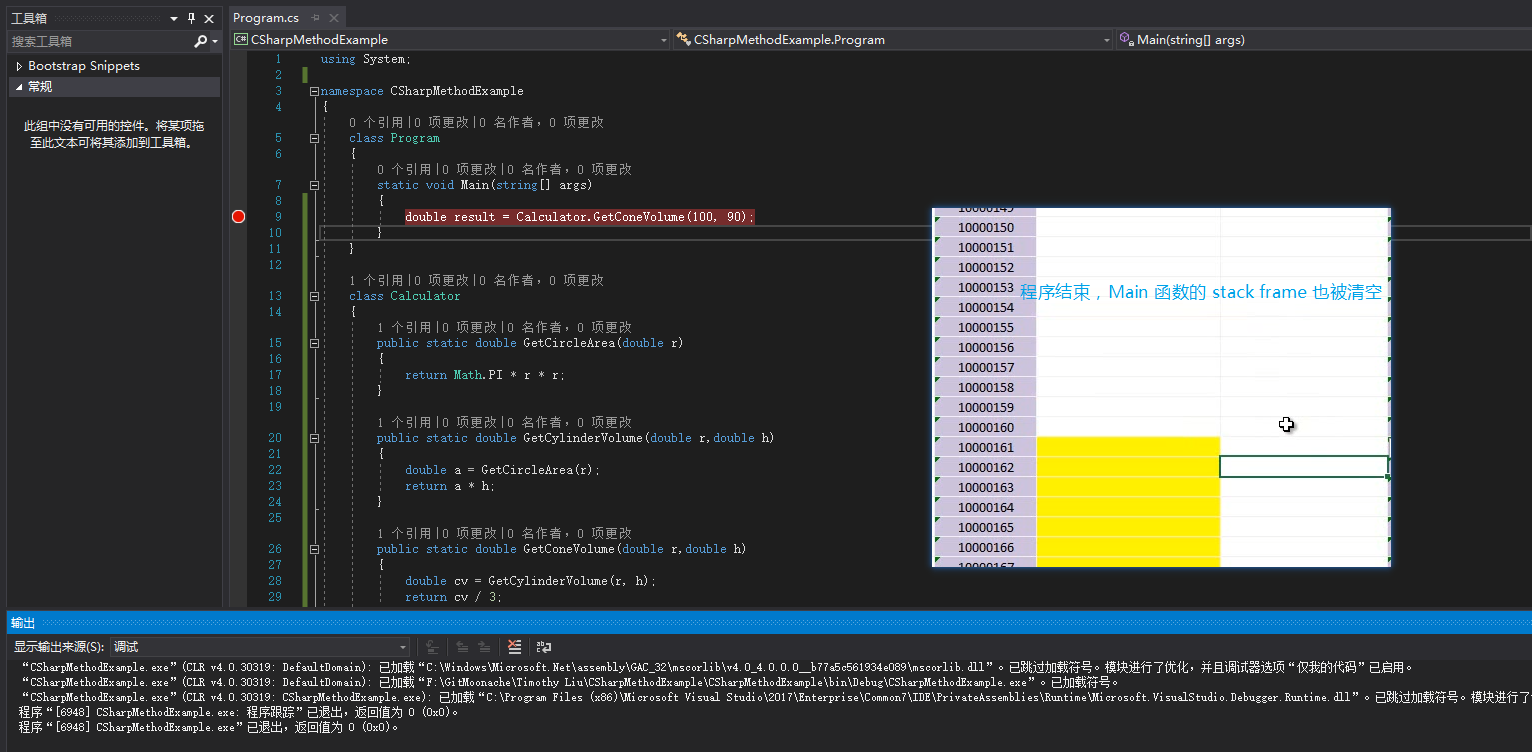方法的由来
方法(method)的前身是C/C++语言的函数(function)
永远都是类(或构造体)的成员
C#语言中函数不可能独立于类(或结构体)之外
只有作为类(构造体)的成员才能被称为方法
C++中是可以的,称为“全局函数”
C# namespace中不能有方法
是类(或结构体)最基本的成员之一
最基本的成员只有两个——字段与方法(成员变量与成员方法),本质还是数据+算法
方法表示类(或结构体)“能做什么事情”
为何需要方法和函数
目的1:隐藏复杂的逻辑;
目的2:复用(reuse、重用)
方法的声明(或称为定义)与调用
using System.Text;using System.Theading,Tasks;namespace CSharpMethodExample{class Program{static void Main(string[] args){Calculator c = new Calculator();Concle.writeLine(GetCircleVolume(50,90));}public static double GetCircleArea(double r){return Math.PI*r*r;}public static double GetCircleVolume(double r,double h){return GetCircleArea(r)*h;}public static double GetConeVolume(double r,double h){return GetCircleVolume(r,h)/3;}}}
构造器(一种特殊的方法)(又称为构造函数)
构造器(constructor)是类型的成员之一
狭义的构造器指的是“实例构造器”(instance constructor)
如何调用构造器 声明构造器
/默认构造器namespace ConstructorExample{class Program{static void Main(string[] args){Student stu = new Student();//创建实例,调用构造器Console.WriteLine(stu.ID);//输出为0,原因是初始化字段值}}class Student{public int ID;public string Name;}}
namespace ConstructorExample{class Program{static void Main(string[] args){Student stu = new Student();Console.WriteLine(stu.ID);Console.WriteLine(stu.Name);}}class Student{public Student(){this.ID = 1;this.Name = "No name";}/自定义构造器数值,不带参数public int ID;public string Name;}}
namespace ConstructorExample{class Program{static void Main(string[] args){Student stu = new Student(2, "Mr.Okay");Console.WriteLine(stu.ID);Console.WriteLine(stu.Name);Student stu = new Student();//此构造器不报错的原因不是为默认构造器,而是自己书写了一个无参数构造器。}}class Student{public Student(int initId,string initName){this.ID = init Id;this.Name = initName;}public Student() //自定义无参数构造器{this.name=1;this.Name= "no name";}public int ID;public string Name;}}
一旦有了带参数的构造器,默认构造器就不存在了。若还想调用无参数构造器,必需自己写。
构造器的内存原理
默认构造器图示
图中左侧代指栈内存,右侧代指堆内存。
注意栈内存分配是从 高地址 往 低地址 分配,直到分配到栈顶。
public int ID;// int 结构体 占4个字节public string Name;// string 引用类型 占4个字节 存储的是实例的地址
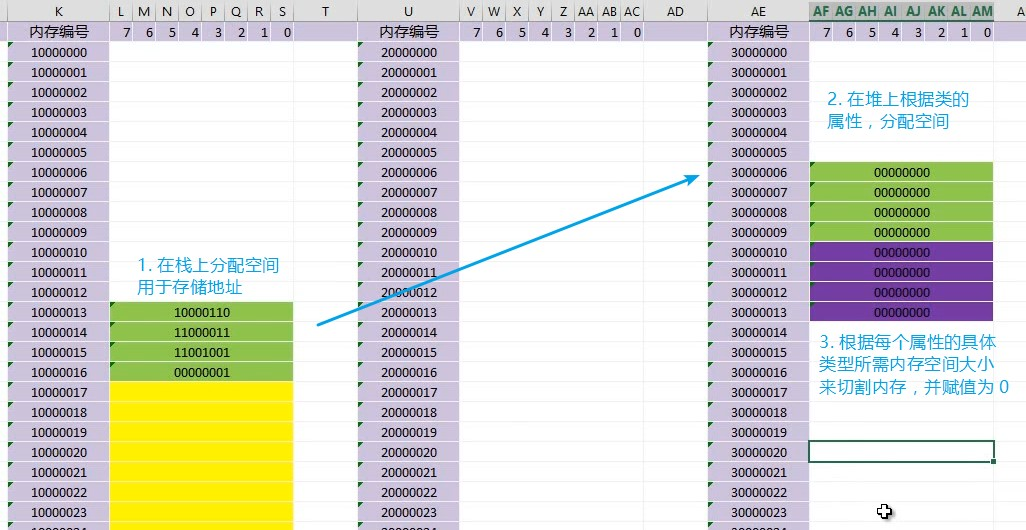
带参数构造器图示
Student stu = new Student(1, "Mr.Okay");
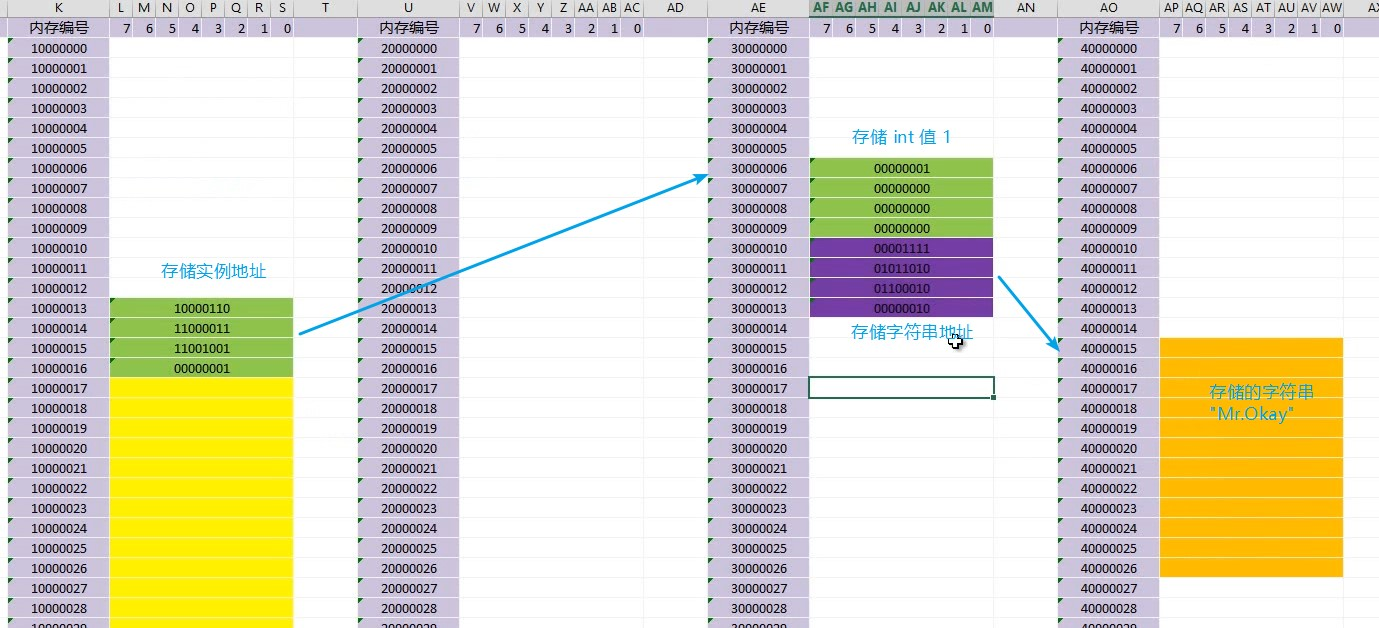
方法的重载(Overload)
调用重载方法示例
namespace OverloadExample{class Program{static void Main(string[] args){Console.WriteLine("");}}}
:::info
此时书写到Console.WriteLine上时,会出现“1 of 19 void Console.WriteLine()”;
声明带有重载的方法
方法签名(method signature)由方法的名称、类型形参的个数和它的每一个形参(按从左到右的顺序)的类型和种类(值、引用或输出)组成。方法签名不包含返回类型
实例构造
public int Add(int a, int b){return a + b;}public int Add(int a, int b,int c) //编译成功,修改形参数量{return a + b + c}public int Add(double a,double b) //编译成功,修改参数类型{return a + b;}public double Add(int a, int b) //编译失败,修改返回值类型{return a + b;}public double Add(int e, int q) //编译失败,修改参数名字{return a + b;}public int Add<T>(int a, int b) //编译失败,类型形参{T t;//...return a + b;}public int Add(ref/out int a, int b) //编译成功,参数种类{return a + b;}
函数签名由它的每一个形参(按从左到右的顺序)的类型和种类(值、引用或输出)组成
重载决策(到底调用哪一个重载):用于在给定了参数列表和一组候选函数成员的情况下,选择一个最佳的函数成员来实施调用
如何对方法进行debug
using System;namespace CSharpMethodExample{class Program{static void Main(string[] args){double result = Calculator.GetConeVolume(100, 90);}}class Calculator{public static double GetCircleArea(double r){return Math.PI * r * r;}public static double GetCylinderVolume(double r,double h){double a = GetCircleArea(r);return a * h;}public static double GetConeVolume(double r,double h){double cv = GetCylinderVolume(r, h);return cv / 3;}}}
设置断点(breakpoint)
断点:程序运行到设置断点位停止运行
操作:点击需要中断位置的,左侧行数空白部分,会出现红色标点。此时断点设置成功。
观察方法调用时的 call stack(调用栈)
通过 call stack 可以直观的追溯方法调用链。
套娃越多,call stack的层数越多。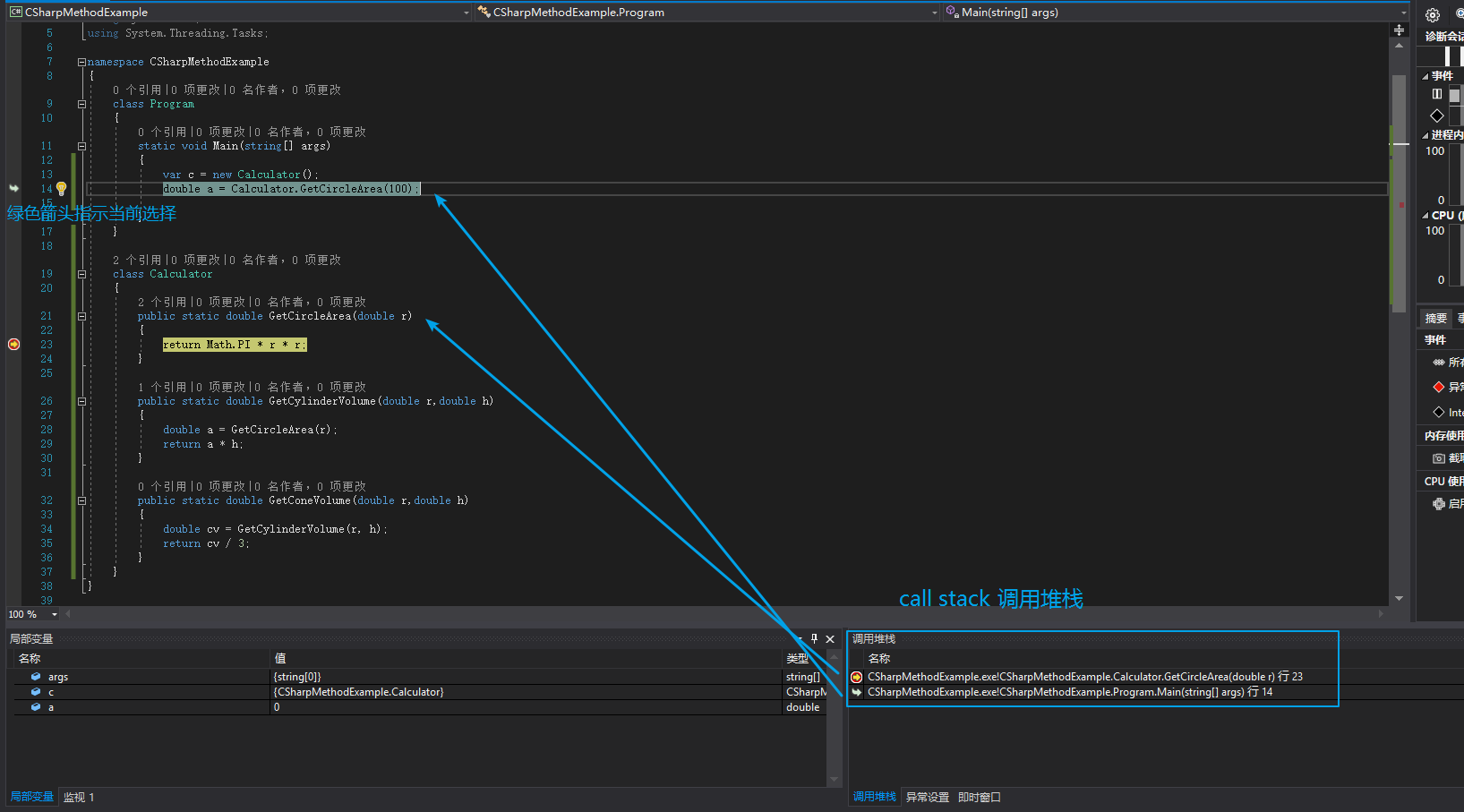
Step-in、Step-over、Step-out
step-in:逐步执行程序(F11)
step-over:用于跳出当前方法并返回到调用它的方法(F10)
step-out:跳转到调用本方法的方法。
现在称为:逐句、逐过程、跳出
观察局部变量的值与变化
Local:会出现程序调用逐步、逐过程等中间运行的值的名称、数值、类型等信息。
方法的调用与栈
方法调用时栈内存的分配
stack frame
一个方法被调用时,它在栈内存中的布局。
C# 中调用方法时的变量归 Caller(主调函数) 管,不归 Callee(被调用者) 管。
压变量入栈,C# 是从左至右的顺序。
图示是为了重点解释方法、变量、参数的压栈,实际情况下还要压入返回地址等。
返回值一般存在 CPU 的寄存器里面,特殊情况寄存器存不下该返回值时,会到栈上开辟空间。
stack overflow 就是栈无限向上延伸(分配变量、参数、栈针等),最后溢出了。
using System;namespace CSharpMethodExample{class Program{static void Main(string[] args){double result = Calculator.GetConeVolume(100, 90);}}class Calculator{public static double GetCircleArea(double r){return Math.PI * r * r;}public static double GetCylinderVolume(double r,double h){double a = GetCircleArea(r);return a * h;}public static double GetConeVolume(double r,double h){double cv = GetCylinderVolume(r, h);return cv / 3;}}}
分步讲解
1.进入 Main 方法,调用 GetConeVolume 方法前
在栈上开辟了 Main 方法的 stack frame。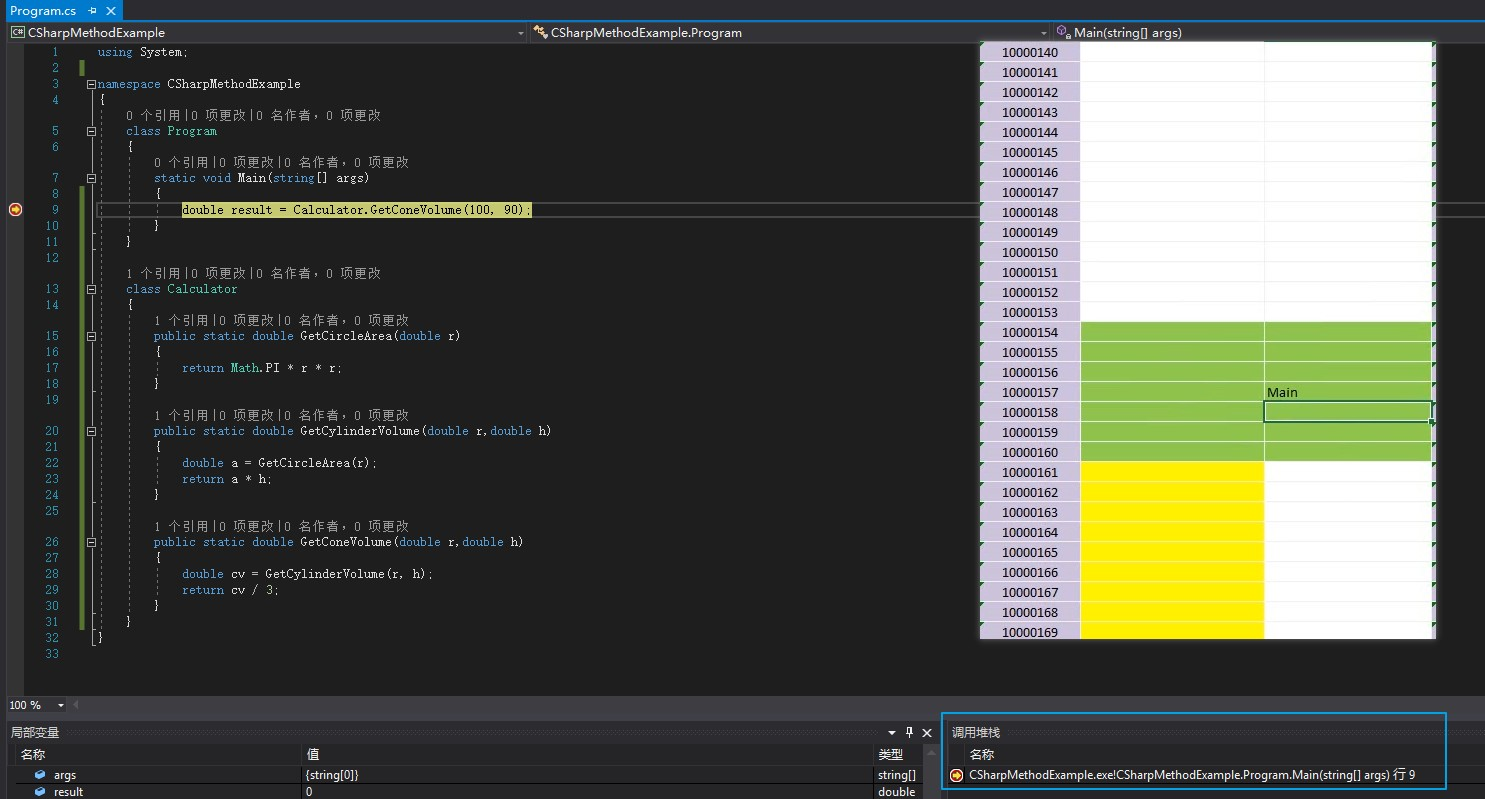
2.Main 方法中调用 GetConeVolume 时
将两个参数压入栈中。因为 C# 中调用时的参数归 Caller 管,此处即归 Main 管。
3.进入 GetConeVolume 后
局部变量是需要入栈的,GetConeVolume 方法中的 cv 入栈。
r,h 也是局部变量,但已经作为参数被 Main 方法压入栈了,所以它只需要压 cv 即可。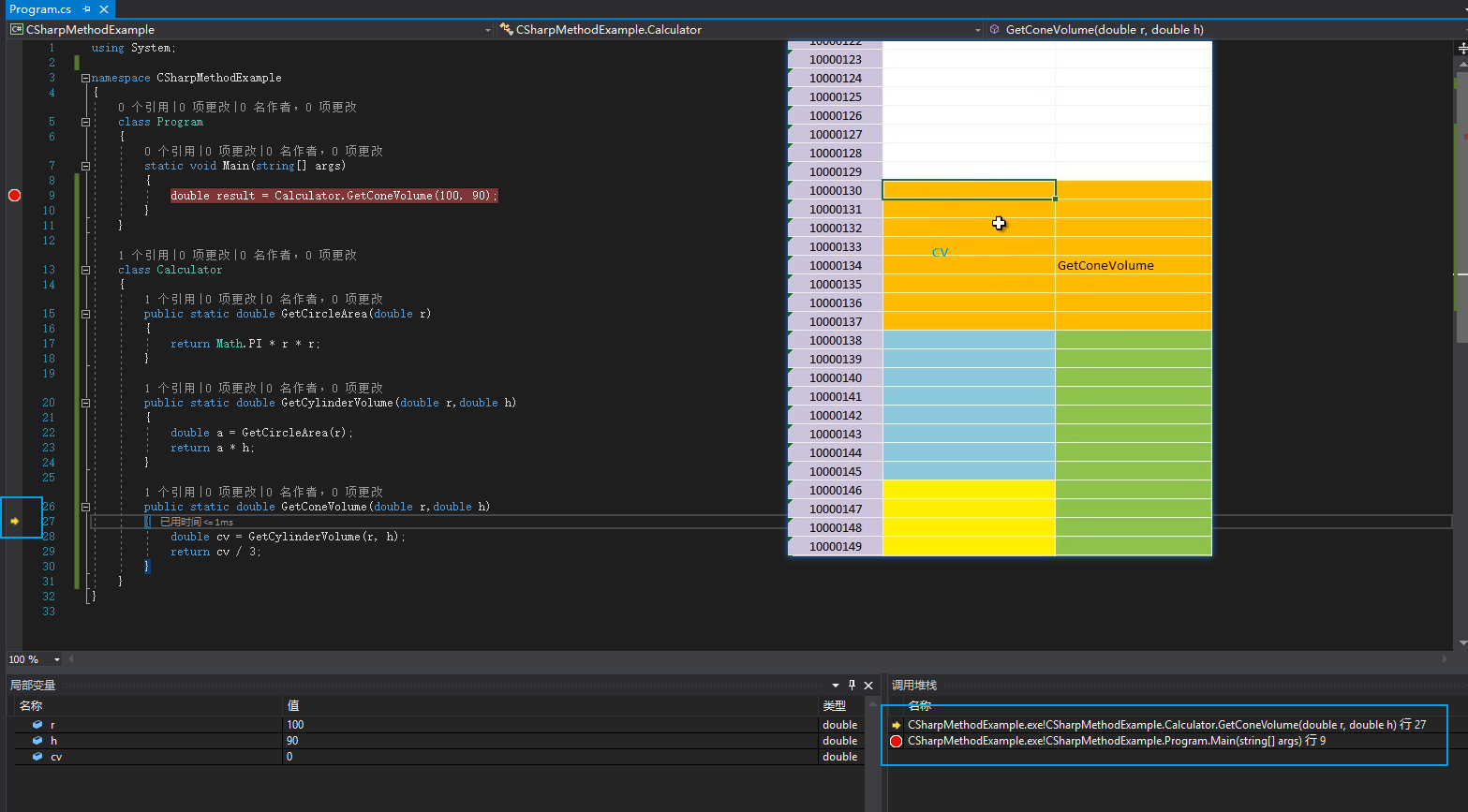
4.GetConeVolume 调用 GetCylinderVolume 时
将两个参数压入栈中。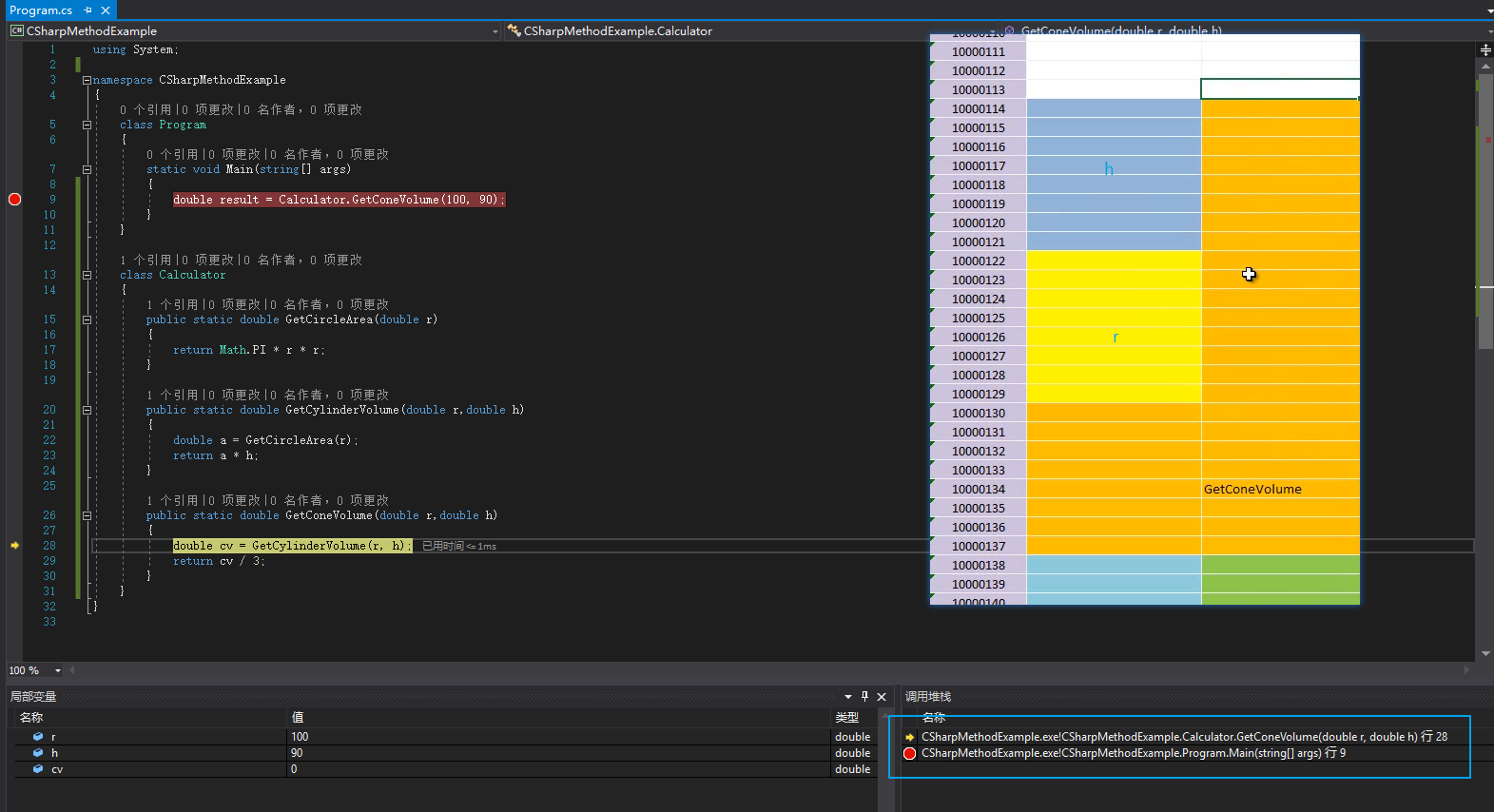
5.进入 GetCylinderVolume 后
局部变量 a 入栈。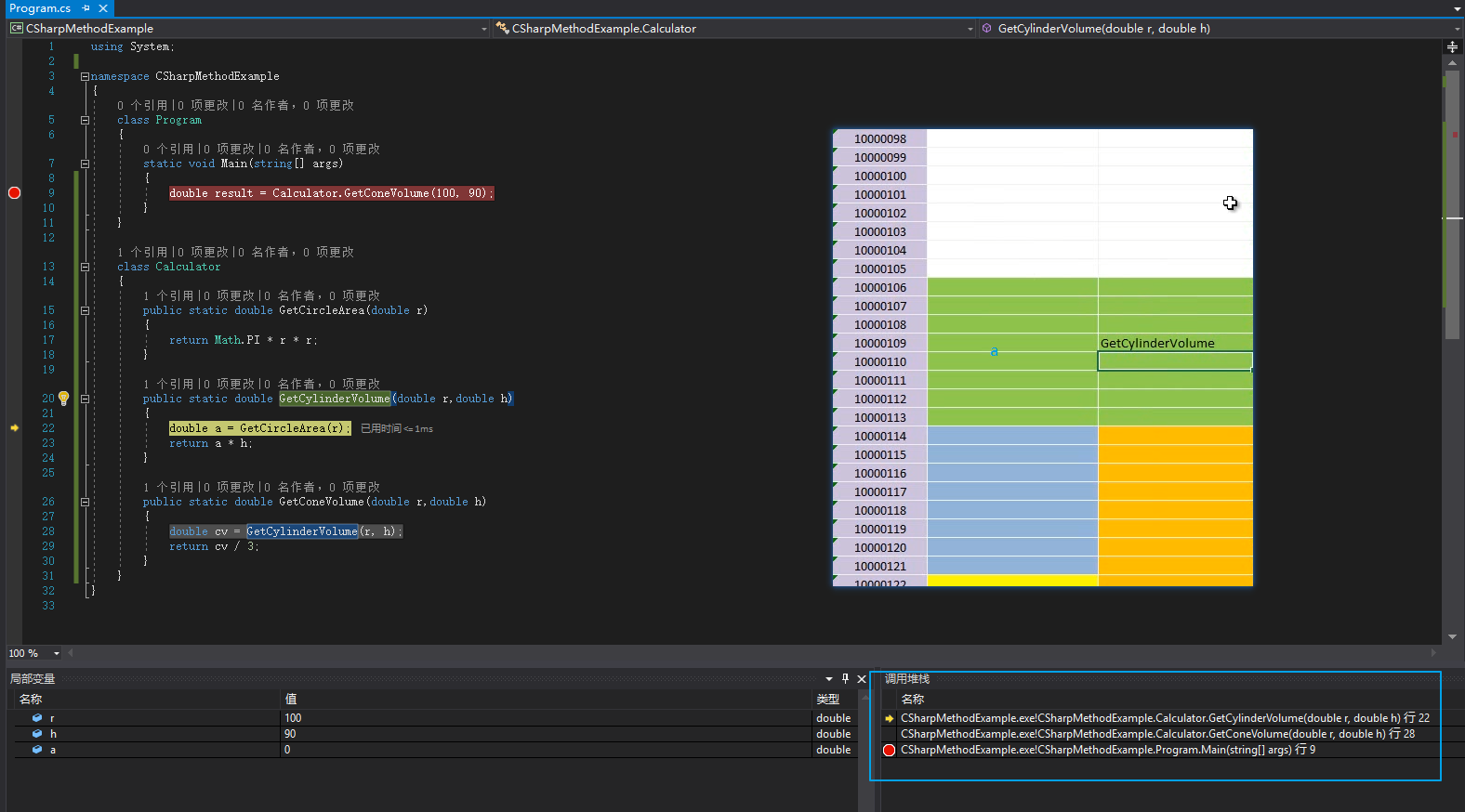
6.GetCylinderVolume 调用 GetCircleArea 时
GetCircleArea 只有一个参数,将其压入栈即可。
7.进入 GetCircleArea 后
GetCircleArea 中没有局部变量,但它在栈上也占内存,它有自己的栈针。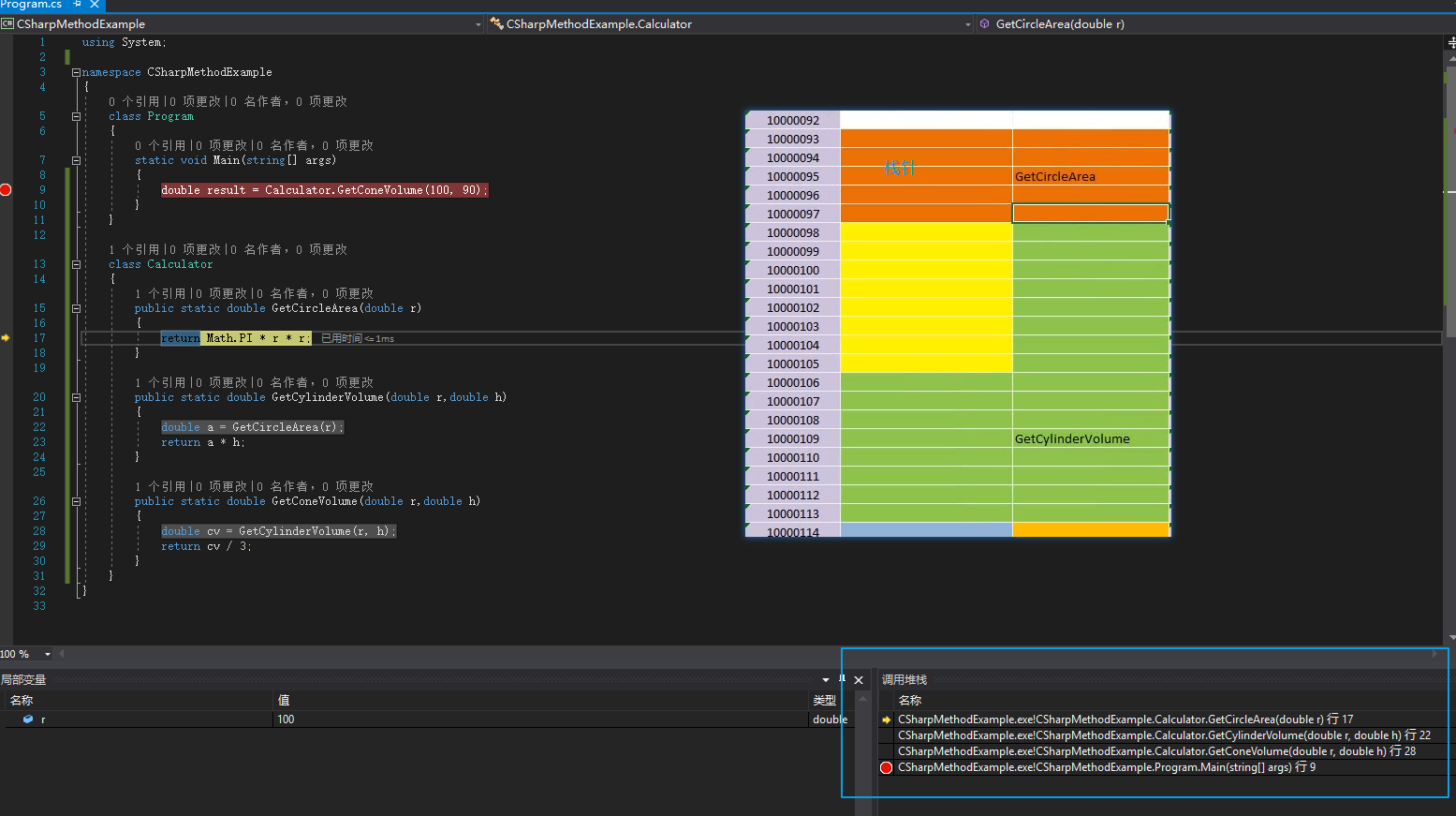
8.GetCircleArea 返回后
返回值存在 CPU 的寄存器(register)里面。
call stack 少了一层。
函数返回后,它所占有的 stack frame 就清空了。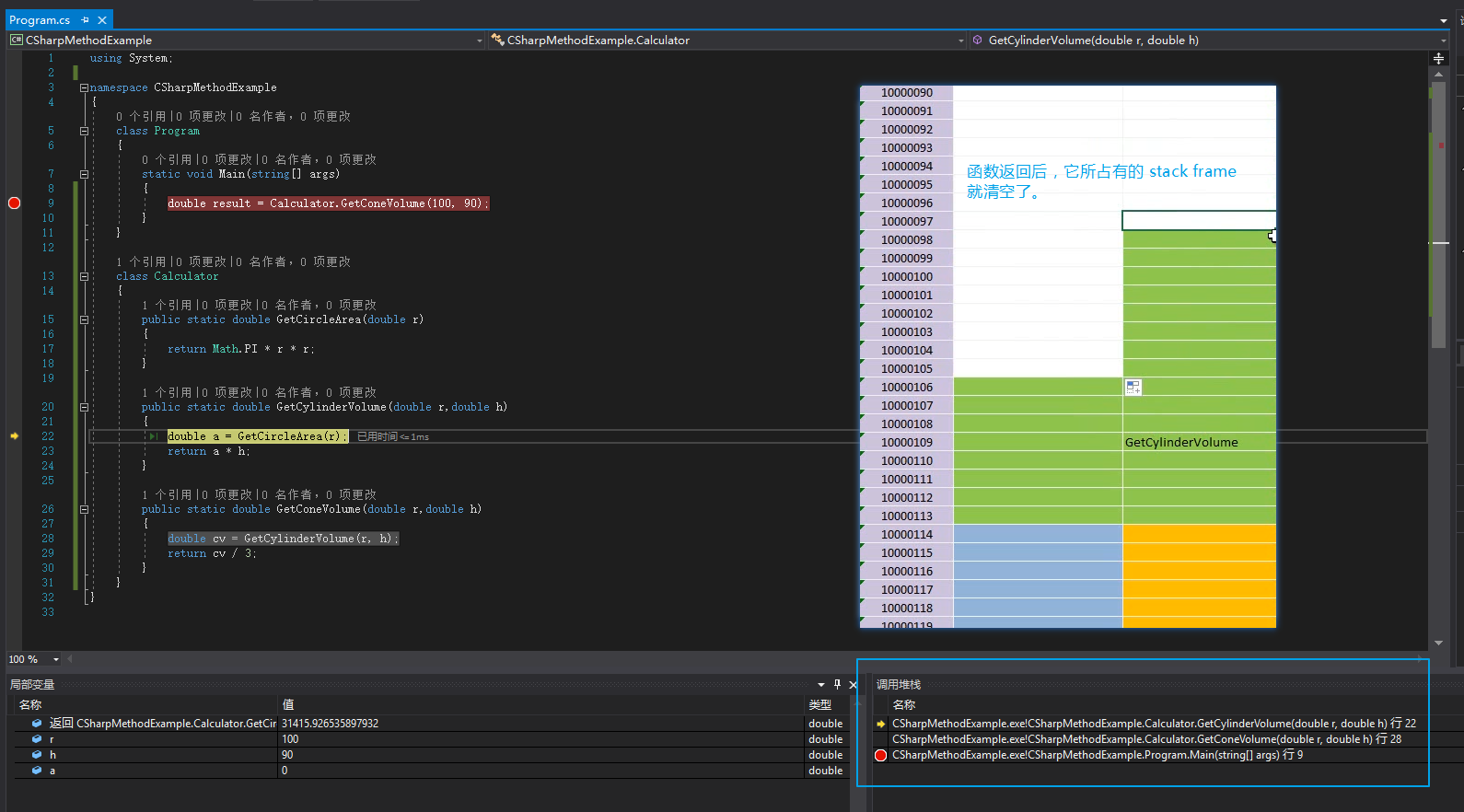
9.GetCylinderVolume 返回后
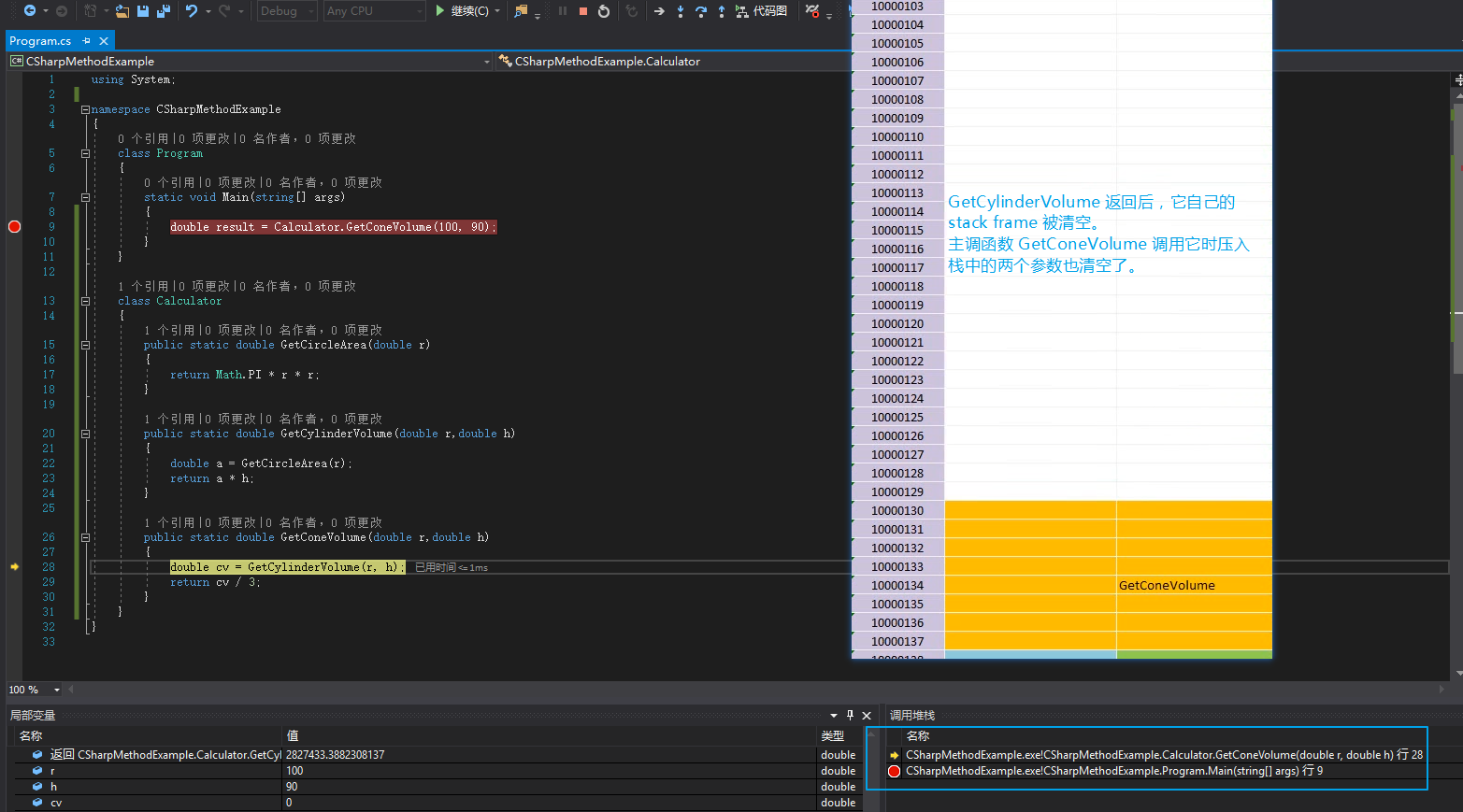
10.GetConeVolume 返回后
GetConeVolume 的 stack frame被清空。
Main 方法中调用 GetConeVolume 时压入栈中的两个参数也出栈了。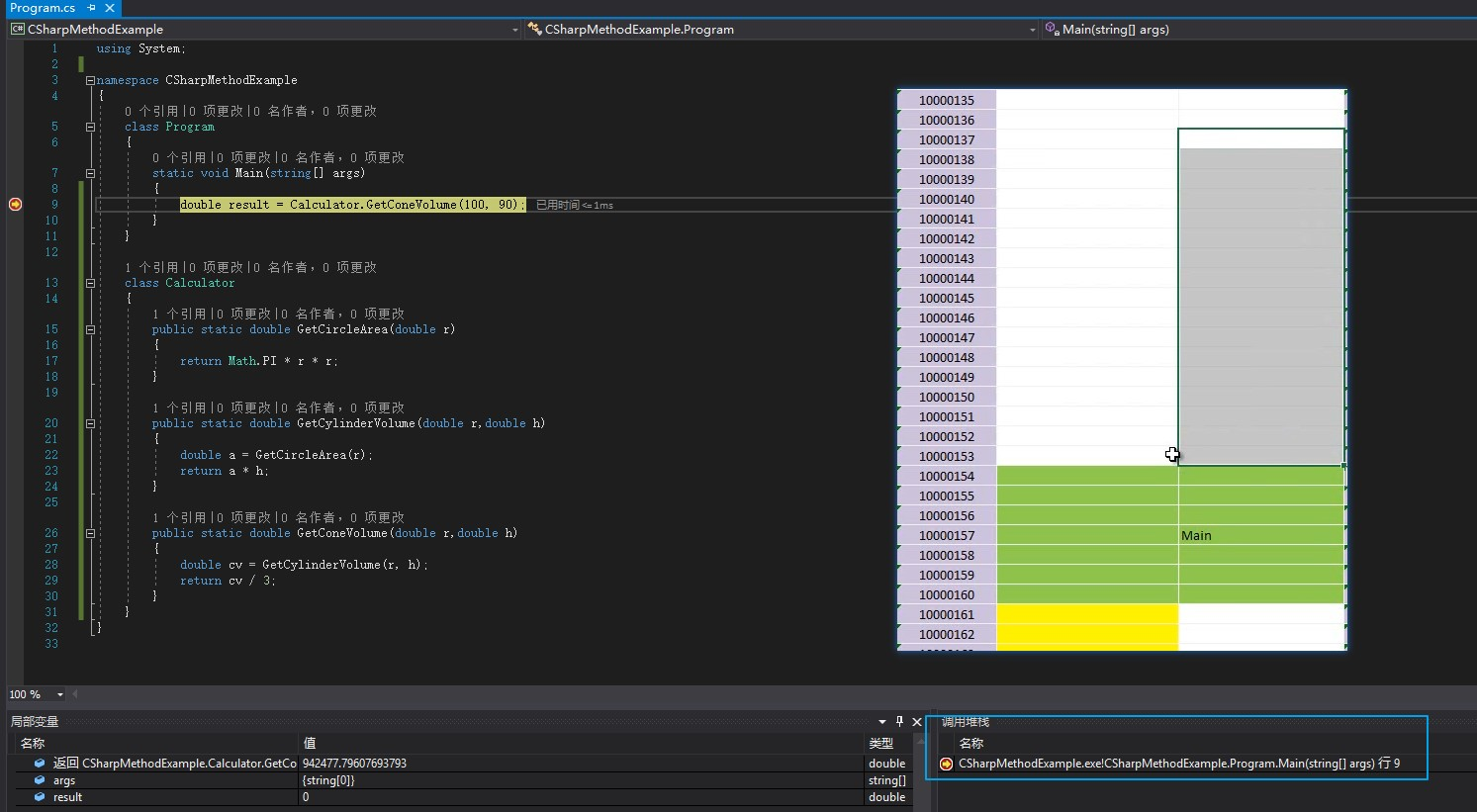
11.Main 返回后(程序结束)
Main 方法的 stack frame 也被清空。